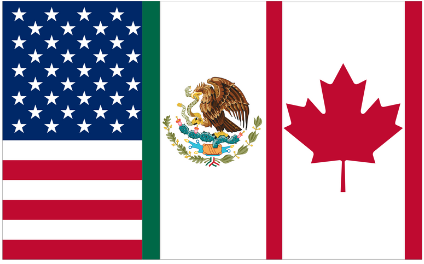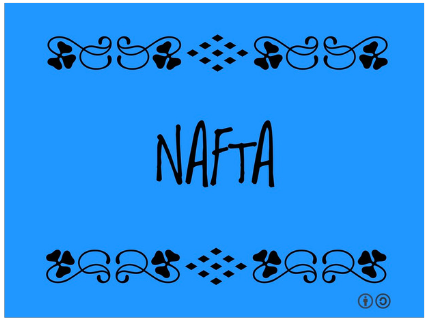




An Overview of NAFTA
The Trade and Tariff Act of 1984 paved the way for a free trade agreement between the US, Mexico and Canada. NAFTA, also known as the North American Free Trade Agreement, is an agreement among the United States, Canada, and Mexico. It is referred to as the tripartite trading bloc of countries of North America. This agreement came into effect in 1994. It is a successor to the Free Trade Agreement between the United States and Canada and NAFTA trumps the Free Trade Agreement.

NAFTA - Agreement Signed Between the United States (left), Mexico (middle), and Canada (right).
What is NAFTA?
The agreement was implemented between the United States, Mexico, and Canada to promote trade. NAFTA added two side agreements, the NAALC (North American Agreement on Labour Cooperation) and NAAEC (North American agreement on environmental cooperation). It focused on eliminating trade tariffs on agricultural products, automobiles, and textiles. This agreement also protected intellectual property rights and removed the restrictions on investment among these three countries. It has also deepened the political relationship among the three signatory countries.

NAFTA - North American Free Trade Agreement
Controversy Related to NAFTA
Since its inception, NAFTA has been the centre of controversy. It was believed that the lower tariffs would help in increasing the profits, but according to the trade and labour unions of the United States and Canada, their jobs are in danger because of the fear of shifting to Mexico due to lower labour costs there.
Moreover, former US President Donald Trump contended that the trade deficit with Mexico and the loss of American jobs are due to NAFTA. For this, he intended to revise the trade agreement with Mexico.
Why was NAFTA in the News?
Due to controversies and issues in the agreement, the three countries talked about overhauling the agreement. In January 2017, it was agreed that a revised agreement would be signed between the countries. The new agreement will address the issues of labour, environment, and the changes in the business environment. It also announced that the deal would make this agreement fairer. The US and Mexico had a consensus, but Canada was not showing any signs of interest.
Canada opposed the new consensus because of the following reasons:
The barriers to the import of dairy placed by Canada. This is because the country wanted to ensure that imports did not harm its farmers.
Who is Canada related to movies, books, and other media? Canada wanted to ensure that its media industries were not overrun by big US rivals.
The trade dispute settlement mechanism.
Despite the tussle between US and Canada, the negotiators have been trying to negotiate the deal because the US wants Canada and Mexico to be a part of it. It is important for the United States because Canada is one of its major export destinations for them.
Later, in September 2018, NAFTA was replaced by USMCA (United States – Mexico – Canada agreement). USMCA took effect on 1 July 2020.
Benefits of NAFTA
The NAFTA benefits are as follows:
It increased cross-border trade and commerce in North America and investment among the three member countries. It quadrupled trade and boosted the economic growth of the countries involved.
It benefited small and medium businesses because of lowered costs and allowed the company to do business in a foreign country without a physical presence.
It established a proper framework for businesses, such as protecting intellectual property rights, establishing dispute resolution mechanisms, and implementing labour and environmental safeguards.
The agreement benefited not only the businesses but also the customers as the prices of the products were lowered. A lower tariff also reduced the import prices, which reduced the risk of inflation and kept the interest rate low, reducing the prices of the products.
Increase in foreign direct investment in Canada and Mexico, which also boosted the profit for businesses based in the US by giving them opportunities for developing and exploring the market. The agreement created a level playing field for the companies within the borders of the three countries.

Agreement of free trade between countries paves the way for other countries to enter the globalised world. Such agreements create a unified world.
Summary
The North American Free Trade Agreement (NAFTA) is both an improving and controversial measure. Though it improved the trade and investment between the three countries, on the other hand, it hurt the economy in terms of employment and environment. The agreement is a matter of debate as there were significant gains and also some losses. The engagement of the three North American countries has laid the foundation of free trade and globalisation for the world.
With the changing business environment, it is important to update the old agreements and transform them into new ones to keep in line with the current changes. The new renegotiated agreement between the United States, Mexico, and Canada, i.e., USMCA, has included the earlier loopholes, to improve the trade agreement.
FAQs on NAFTA: North American Free Trade Agreement Overview
1. What was the purpose of the North American Free Trade Agreement?
The North American Free Trade Agreement was signed to decrease the trade cost, reduce tariffs and trade barriers, and increase investment among the three North American nations that are the United States, Mexico, and Canada. NAFTA was inspired by the success of the European Economic Community agreement, which eliminated the barriers to trade among its members and resulted in growth, increased trade and profit. The agreement's main aim was to make North America more competitive globally. The agreement quadrupled the trade between these countries and increased the economic output of the countries.
2. What are the disadvantages of NAFTA?
The cons of NAFTA are as follows:
As the companies focus on Mexico, job losses among Americans because lower labour costs in Mexico.
Secondly, now stop putting the Mexican farmers out of view because the US government subsidised farm products that were allowed into Mexico against which the local farmers of Mexico couldn’t compete.
Thirdly, the poor working conditions and the substandard work environment in Mexico, where products were assembled and exported to the US.
Lastly, damage to the environment was huge as the focus was on lowering costs and ignoring the environment, leading to increased deforestation and pollution.
3. Explain the increase in North America GDP due to NAFTA.
The increase in trade between the three countries, the US, Canada, and Mexico, resulted from the free trade agreement, which removed the tariff and non-tariff barriers between the countries. Due to the North American Free Trade Agreement (NAFTA), the overall trade in nominal terms saw a 258.5% increase and resulted in economic growth. In numbers, the trade grew from





















